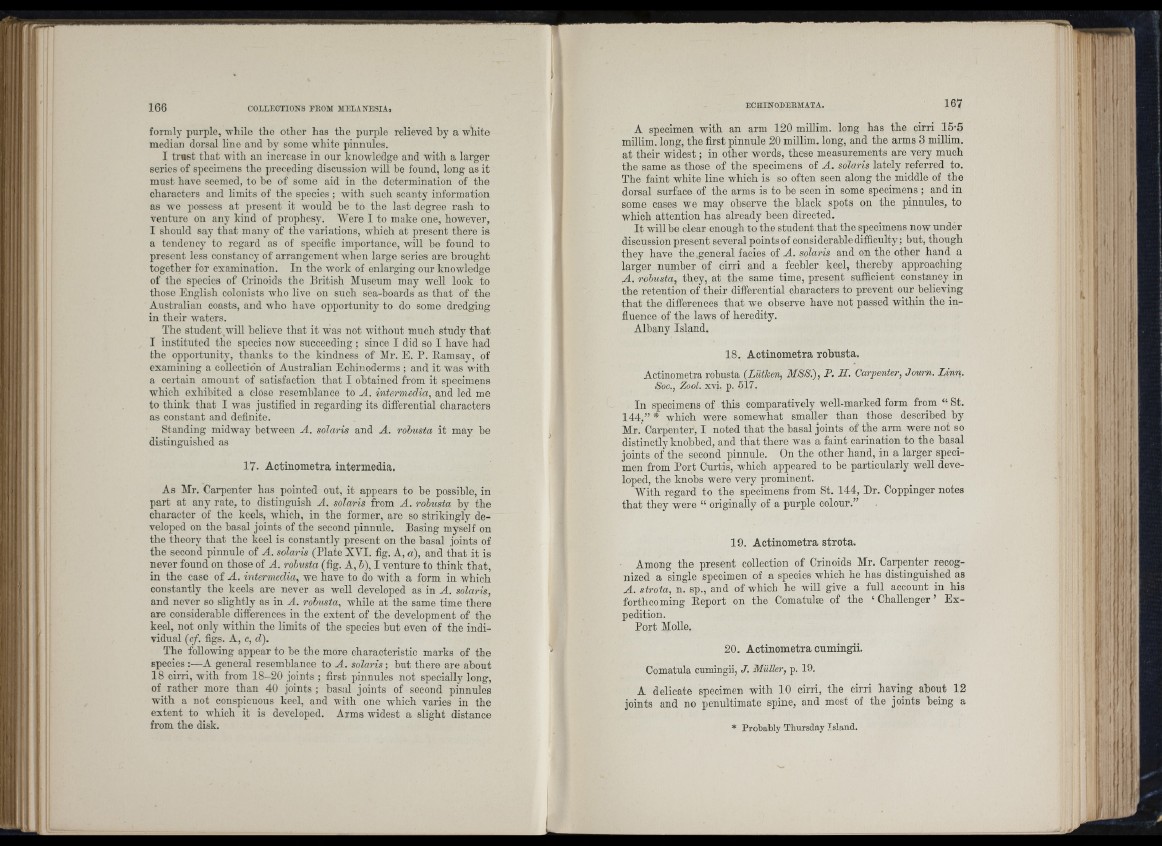
i l
I
'I
Ili i
Y
ll
,-ì
; ì
formly purple, while tho other has the purple relieved by a white
median dorsal lino and by some white pinnules.
I trust th a t with an increase in our knowledge and with a larger
series of specimens tho preceding discussion will he found, long as it
must have seemed, to he of some aid in the determination of the
characters and limits of the species; with such scanty information
as we possess at jiresent it would be to the last degree rash to
venture on any kind of prophesy. Were I to make one, however,
I should say th at many of the variations, which at present there is
a tendency to regard as of specific importance, will ho found to
present less constancy of arrangement when large series are brought
together for examination. In the work of enlarging our knowledge
of the species of Crinoids the British Museum may well look to
those English colonists who live on such sea-boards as th at of the
Australian coasts, and who have opportunity to do some dredging
in their waters.
The student will believe that it was not vrithout much study th at
I instituted the species now succeeding ; since I did so I have had
the opportunity, thanks to the kindness of Mr. E. P. Pamsay, of
examiniDg a collectio’n of Australian Echinoderms ; and it was vdth
a certain amount of satisfaction th at I obtained from it specimens
which exhibited a close resemblance to A . intermedia, and led me
to think th a t I was justified in regarding its differential characters
as constant and definite.
Standing midway between A . S o la r i s and A . rohusta it may be
distinguished as
17. Actinometra intermedia.
As Mr. Carpenter has pointed out, it appears to he possible, in
part at any rate, to distinguish A. solaris from A . robusta by the
character of the keels, which, in the former, are so strikingly developed
on the basal joints of the second pinnule. Basing myself on
the theory th at the keel is constantly present on the basal joints of
the second pinnule of A. solaris (Plate XYI. fig. A, a), and th at it is
never found on those of A. rolmta (fig. A, h), I venture to think that,
in the case of A . intermedia, we have to do with a form in which
constantly the keels are never as well developed as in A . solaris,
and never so slightly as in A . rohusta, while at the same time there
are considerable differences in the extent of the development of the
keel, not only within the limits of the species hut even of the individual
(cf. figs. A, c, d).
The following appear to he the more characteristic marks of the
species A general resemblance to A . solaris; but there are about
18 cirri, with from 18-20 joints ; first pinnules not specially long,
of rather more than 40 joints ; basal joints of second pinnules
with a not conspicuous keel, and with one which varies in the
extent to whieh it is developed. Arms widest a slight distance
from the disk.
> A:
A specimen with an arm 120 millim. long has the cirri 15-5
millim. long, the first pinnule 20 millim. long, and the arms 3 millim.
a t their widest ; in other words, these measurements are very much
the same as those of the specimens of A . solaris lately referred to.
The faint white line which is so often seen along the middle of the
dorsal surface of the arms is to be seen in some specimens ; and in
some cases we may observe the black spots on the pinnules, to
which attention has already been directed.
I t will be clear enough to the student th at the specimens now under
discussion present several points of considerable difficulty; but, though
they have the general facies of A . solaris and on the other hand a
larger number of cirri and a feebler keel, thereby approaching
A . rohusta, they, at the same time, present sufficient constancy in
the retention of their differential characters to prevent our believing
th at the differences th at we observe have not passed within the influence
of the laws of heredity.
Albany Island.
18. Actinometra rohusta.
Actinometra rohusta (Lütken, M S S ), P. LI. Carpenter, Journ. Linn.
Soc., Zool. xvi. p. 517.
In specimens of this comparatively well-marked form from “ St.
144,” * which were somewhat smaller than those described by
Mr. Carpenter, I noted th a t the basal joints of the arm were not so
distinctly knobbed, and th at there was a faint carination to the basal
joints of the second pinnule. On the other hand, in a larger specimen
from Port Curtis, which appeared to be particularly well developed,
the knobs were very prominent.
With regard to the specimens from St. 144, Dr. Coppinger notes
th a t they were “ originally of a purple colour.”
19. Actinometra strota.
Among the present collection of Crinoids Mr. Carpenter recognized
a single specimen of a species which he has distinguished as
A . strota, n. sp., and of which he will give a full account in his
forthcoming Beport on the Comatulse of the ‘ Challenger’ E x pedition.
Port Molle.
20. Actinometra cumingii.
Comatula cumingii, J. Miiller, p. 19,
A delicate specimen with 10 cirri, the cirri haying about 12
joints and no penultimate spine, and most of the joints being a
* Probably Thursday Island.
r w r -
0 o
? I ;)i
I ■ Í!
Í